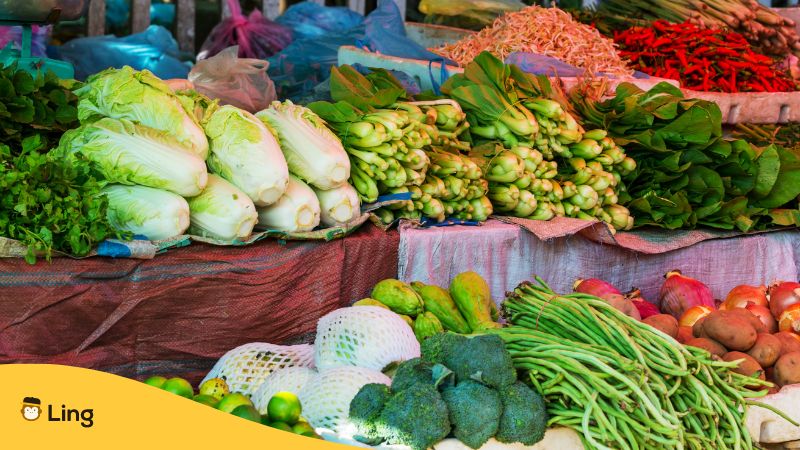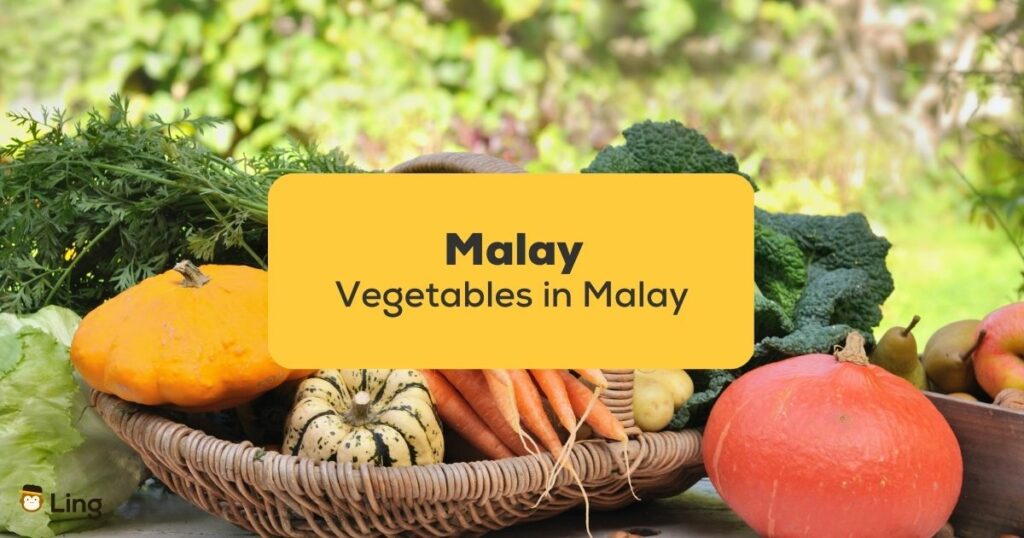Learning about sayur-sayuran or vegetables in Malay is important because it helps you build a strong foundation in the language. Imagine going to a Malay restaurant and being able to order your favorite veggie dish without having to point at the menu. Wouldn’t that be great? You can also use these words in a conversation with a Malay friend or when shopping for vegetables at the market. In this post, we’ll review all the translations and everything you need to know about this topic. Let’s start!
Did you know Malaysia’s climate is ideal for growing various crops, including fruits, vegetables, and spices? You see, the country is located in Southeast Asia and is made up of two main regions: Peninsular Malaysia and East Malaysia.
Peninsular Malaysia, also known as West Malaysia, is located on the southern tip of the Malay Peninsula. Its climate is tropical and humid, and there are two monsoon seasons, the Southwest Monsoon (from April to September) and the Northeast Monsoon (from October to March). East Malaysia, also known as Malaysian Borneo, is located on the island of Borneo and is made up of the states of Sabah and Sarawak. Its climate is also tropical and humid, but it is generally a bit cooler than Peninsular Malaysia and receives more rainfall.
Before we look into vegetable names and some fruits, let’s briefly discuss the agricultural industry in Malaysia.
Agriculture In Malaysia
The agricultural industry in Malaysia has been an important sector of the country’s economy for many years. However, in recent decades, the industry has faced several challenges, including declining land productivity, labor shortages, and competition from cheaper imports.
Despite these challenges, Malaysia has maintained a relatively high level of agricultural production and is one of the world’s leading producers of rubber, palm oil, and cocoa. The country is also a significant producer of other crops such as rice, pineapple, coconuts, and pepper.
The government of Malaysia has implemented several policies and programs to support the agricultural industry, including the development of modern farming techniques and the promotion of agro-tourism. Additionally, the government has been actively promoting technology and digitalization in the farming industry to increase efficiency and productivity.

Vegetables In Malay According To Seasons
Here are some vegetables in different seasons in the Malay language:
Spring
- Bayam (spinach)
- Buncis (green beans)
- Sawi (mustard greens)
Summer
- Terung (eggplant)
- Timun (cucumber)
- Tomato (tomato)
Fall
- Kentang (potatoes)
- Wortel (carrots)
- Kacang panjang (yardlong beans)
Winter
- Lobak (radish)
- Kubis (cabbage)
- Bawang (garlic)

Vegetable Names In Malay
Look at a robust list of vegetable names below – all in English and Malay.
- Terong (Eggplant)
- Timun (Cucumber)
- Buah tomato (Tomatoes)
- Sawi (Mustard greens)
- Bayam (Spinach)
- Buncis (Green beans)
- Kentang (Potatoes)
- Wortel (Carrots)
- Kacang panjang (Yardlong beans)
- Lobak (Radish)
- Kubis (Cabbage)
- Bawang (Garlic)
- Kacang buncis (snap beans)
- Labu (Squash)
- Benda (Bitter gourd)
- Kacang hijau (Green peas)
- Kacang botol (Bottle gourd)
- Kacang merah (Red beans)
- Kacang panjang (Yardlong beans)
- Kacang putih (White beans)
- Kacang semangka (Watermelon seeds)
- Kacang tanah (Groundnuts)
- Kacang tepung (Flour beans)
- Kacang tolo (Broad beans)
- Kacang-kacangan (Legumes)
Vegetable Dishes In Malaysia
What use are vegetable names if you do not know vegetarian dishes in Malaysia? Here are a few examples with varieties of ingredients. Try out these healthy and plant-based options, and you may forget your salads and soups!
As the country is a melting pot of different cultures, you’ll find several cuisines, including Chinese and Indian, that have been adapted to suit the local taste and ingredients.
- Nasi Lemak: This is a traditional Malay dish that consists of steamed rice cooked in coconut milk and pandan leaves, served with a variety of side dishes such as peanuts, anchovies, and a hard-boiled egg. Vegetarian versions of this dish are commonly made with tempeh or tofu instead of meat.
- Mee Goreng: This is a popular street food dish with stir-fried egg noodles and vegetables. It is often made with tofu or tempeh and can be quite spicy.
- Roti Canai: This is a type of flatbread that is commonly eaten for breakfast. It is usually served with dal (lentil curry) or vegetable curry.
- Satay: These are skewers of grilled meat or tofu, which are usually served with peanut sauce and cucumber relish.
- Laksa: This is a popular noodle soup dish that is made with a spicy coconut milk-based broth. Vegetarian versions of this dish are commonly made with tofu or tempeh.
- Gado-Gado: This is a popular Indonesian dish that is made with steamed vegetables and tofu, which are served with peanut sauce.
- Curry Puff: A popular deep-fried pastry filled with curry potatoes, onions, and sometimes with vegetables or tofu.

Learn Malay With The Ling App
With a good grip on vegetables in Malay, perhaps you’re also wondering if it’s possible to learn more Malay today. Well, you’re in luck! Try downloading the Ling app, a gamified language learning app where you can learn Malay in the most fun, fulfilling, and fastest way possible.
Besides having amazing, well-categorized lessons for a great variety, it has quizzes, voice recognition to practice speech, and also a huge library of real voices of native speakers to make your experience extra special. Another convenient part – it has three pricing plans which are not difficult on the wallet! Read the Ling App review from users and see for yourself. Choose an app that is waiting to cheer you up and celebrate your victories as you learn a new language.






























































